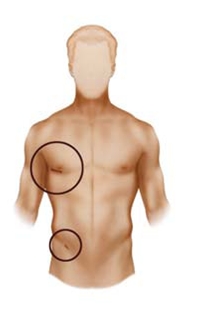Traditionally, surgeons access a patient’s heart by performing a sternotomy, which involves opening the breast bone to gain exposure of the heart. Minimally invasive heart surgery is performed through a small incision made under the patient’s breast, whereby the surgeon uses special instruments to access the heart through the rib cage. The incision is about 2 to 4 inches instead of the 6- to 8-inch incision required for a traditional sternotomy.
The benefits of minimally invasive heart surgery include a smaller incision and scar, lower risk of infection, less bleeding, less trauma, a potentially decreased hospital stay and a quicker return to normal activities. The average stay after minimally invasive cardiac surgery is 3 to 5 days, while the average stay after traditional open surgery is 5 days.
Minimally invasive cardiac surgery can be used as an approach to valve repair, valve replacement, coronary artery bypass graft (CABG) surgery and the treatment of atrial fibrillation.
Traditional Approach

Minimally Invasive Approach

